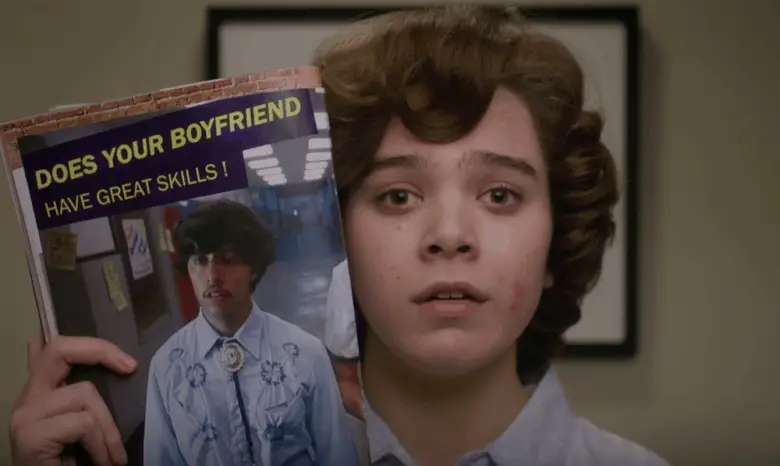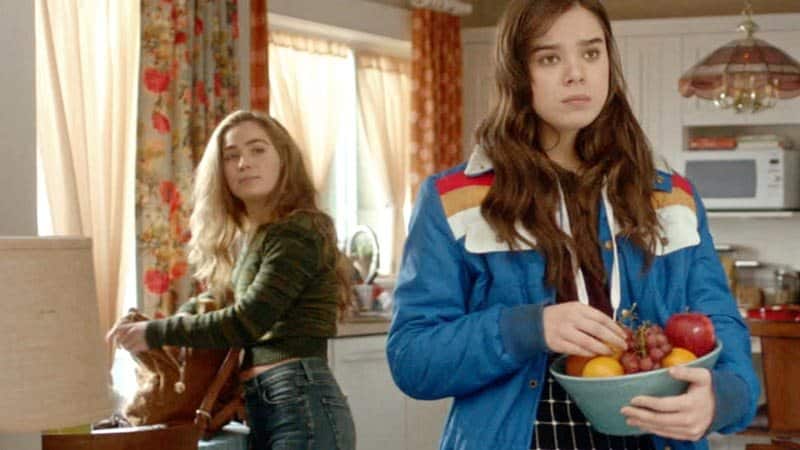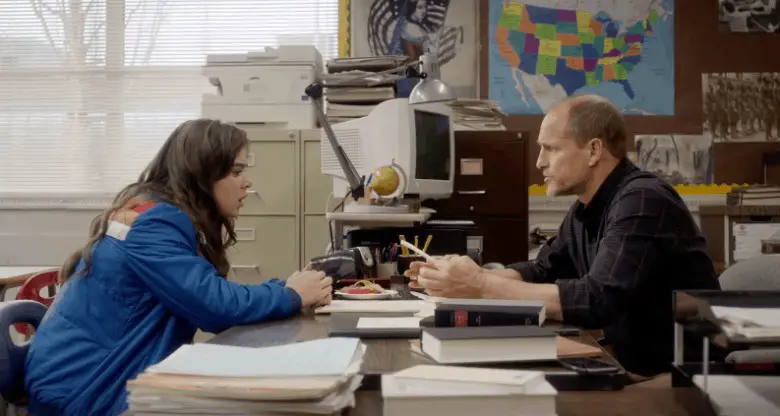The Edge of Seventeen is a coming-of-age movie about an American girl called Nadine who struggles to fit in. That could describe many of us in our teen years, but with Nadine there’s a bit more to it.
STORY STRUCTURE OF THE EDGE OF SEVENTEEN
The film opens to a witty, high stakes dialogue scene in which Nadine rushes to her history teacher and tells him she’s going to kill herself. Mr Bruner is an excellent contrast to Nadine because he is calm and ironic and on the face of it, cruel. Nothing is a drama to him, not even suicide threats from students.
Next we have Nadine as storyteller narrator guiding us through her early life. This ends with her father dying two years back, and she sums this period up as ‘it was shit’ so she doesn’t bore us with the details. The father is grounded while the mother is not. Basically, the writers are taking a girl and doing the worst possible thing to her — taking away her father just as she enters the adult world. We’ve seen just enough of the father to fall in love with him ourselves, too.
When we’re in ‘the present’ the story starts in earnest, with Nadine talking to her best friend under a tree at lunch break, announcing her desire to have sex.

SHORTCOMING
I’m not suggesting the writers knowingly did this, but I read Nadine as an autistic girl. I believe we’re to read Nadine as living with depression. My reasons for autism in no particular order:
- She has problems making any friends (at all) in primary school. This isn’t just a depressive episode — this is a lifelong struggle with social interactions.
- Eventually another little girl approaches her with a caterpillar and because this other girl is kind and nurturing they are best friends for years.
- When this relationship breaks up Nadine literally has no one else to turn to. She has been clinging possessively to this one friend the whole time. She has expanded her social circle only by clinging on to the sardonic history teacher who spends lunchtimes in his classroom avoiding people. She either doesn’t notice his bluntness or finds it at least understandable.
- She is inclined to ‘burn bridges’. When she cuts off Krista for dating her brother this really feels like it could be done forever.
- Her mother says at one point, “I’m done trying to understand you!” (Even her own mother doesn’t understand her.) A lot of people don’t understand autism, especially as it typically presents in girls.
- Nadine is interested in love and sex but gets herself into a situation she really doesn’t want. The whole thing is better inside her head. But she doesn’t know she doesn’t want it until she’s right in it. She is socially naive. She also makes an offer to Erwin which he takes seriously. She wants to make jokes but doesn’t quite know how to do it. She explains that she was only parodying a movie when she asked him if he wanted to have sex with her in the pool.
- She has no idea what to do at parties but is nevertheless drawn to them. When she finds one girl to talk to it turns out that girl is also socially inappropriate, so rather than rejoin the group she takes off, telling Erwin the party was ‘cancelled’.
- After getting herself into an unwanted hookup with a boy who doesn’t like her as a person she makes reference to the make and model of the boy’s car. He accuses her of making fun of his car. She says “No, I was just being specific about the car.” Miscommunication + keen eye for detail + tendency to be unnecessarily specific.
- Nadine is prone to anxiety and depression and is constantly viewing herself from the outside. She has internalised society’s criticism of her. Girls on the spectrum, or with any other invisible differences, get criticised a lot.
- She hasn’t passed her driver’s licence. A disproportionate number of autistic people have trouble with that. This means she’s behind her peers in terms of freedom and reliance on other people.
So there you have it. Call it depression or autism or plain old end-of-childhood, those are Nadine’s psychological and moral shortcomings in a nutshell.
Her problem is that her social circle isn’t wide enough to withstand relationship break ups.
DESIRE
As mentioned above, the main desire line revolves around Nadine wanting to have sex with a particular boy. It’s significant that the writers had her announce this intention right at the beginning of the ‘present timeline’ within the world of the story because until the main character wants something the audience can’t ‘care for the character’. She says the boy is “so much more attractive since he came back from juvie.” And that’s all we really need to know about him.
Of course Nadine wants other things more generally and in a deeper way. She wants her best friend to stop dating her brother, for instance. She wants her mother and brother to get off her back. She wants independence. But these desire lines are at a higher level of abstraction, so in order to drive the story forward the writers gave Nadine the very specific, and comedically ripe, goal of wanting to have sex with the boy who just got back from juvenile detention. (She is the ‘anti-Kat’ from 10 Things I Hate About You.)
Because Nadine is so lacking in self-awareness, the audience knows immediately in a form of dramatic irony that this thing with the juvie boy is a self-destructive desire and will not work out at all. Partly this is because movies are inherently conservative, even the indie films like this one, because we have mostly internalised the idea that when girls have sex with bad boys, for the sake of having sex, the girl will end up hurt. There is no question in our minds that she could hook up once with the bad boy, have great sex, and walk away a slightly more rounded person.
Also because Nadine is so lacking in self-awareness she will change her mind before the end of the movie. The audience knows she will. She’ll realise that the socially awkward but rich and talented and handsome Erwin is a much better match for her. Characters don’t often change their minds about what they want but it does occasionally happen in a story, as it’s connected to the anagnorisis (that they were wrong about themselves). Another film which does this is Legally Blonde. The main character thinks she wants the boy but it turns out she wants a career.
OPPONENT
Nadine’s opponents are also the people closest to her.
- Her brother Darian is interesting because he is presented to the audience as a classic jock. Over the course of the movie we learn that there is far more to him than the beefed up, health conscious athlete. He takes over as caregiver after their father dies, because the mother is also neurotic. For Nadine he is an opponent because he has everything she wants. He is handsome, popular and socially adept. He is the golden haired boy when it comes to their mother. Classic sibling rivalry but taken to the extreme.
- Krista is a best friend who suddenly becomes an opponent when Nadine disapproves of her sleeping with her brother. She has ‘joined the dark side’. In the story Krista is not given much in the way of ‘personality’ or ‘spark’. She is the Diana of Green Gables, or any other nice girl who exists in contrast to a fiery heroine.
- Nadine’s mother undergoes a bit of a character arc when she texts ‘OK’ instead of requesting Nadine call her immediately. She has realised that what Nadine needs is a bit of freedom, and that she can’t do anything to help her out anyway.
- The audience probably knows that the history teacher is playing a part when he pretends to be this uncaring person who hates teaching. Mr Bruner is a ‘fake opponent ally’ who looks after Nadine later when she’s in crisis mode. He also gives her money for a frozen yoghurt. We suspect he’s in his classroom at lunchtime not to avoid everyone, but for precisely the opposite reason — to be there for the oddballs who need him. We also have it confirmed that he is not what he seems when we see he’s got a wife and family — this is after Nadine has accused him of being bald, lonely and single.


PLAN
Nadine (sort of) plans to have sex. With the juvie guy (Nick). She mistakenly thinks having sex will plunge her into adulthood and she can bypass the rest of the awkward inbetween years. She tells Krista she’s going to have sex with him in the Petworld storeroom and the audience thinks she’s joking, but she really does stalk him at his workplace, and in an ill-considered moment she accidentally sends a stream-of-consciousness offer of sex, which he takes her up on.
This plunges her into her main crisis and she runs to the history teacher in a repeat of what we saw in the opening scene. The most memorable line is repeated, “I’m going to kill myself” then there is a cutaway and we understand the initial scene just took place.
BIG STRUGGLE
Nadine has a very bad day. She won’t get out of the car when her mother drops her off. The mother decides to just take her to work with her and she can sit there and be quiet. Nadine takes off in her mother’s car. She arranges to meet up with the boy for sex. She is abandoned after that goes all to hell. She has no choice but to call the history teacher to rescue her, then she won’t get into her brother’s car when he turns up to give her a ride home. This sequence naturally provides much opportunity for interpersonal conflict.
ANAGNORISIS
After Erwin awkwardly presents his short film on stage Nadine realises she really likes him. She gives him a bunch of flowers and tells him, in a supremely awkward moment, that she realises the film was about her.
The audience, also, has been lead to believe the film was about her. But in a surprise ending, Erwin tells her it wasn’t about her at all. We have been seeing the world guided by Nadine as storyteller, so this comes as a surprise to the audience as much as to Nadine. We may choose not to believe Erwin when he says this. His actions have spoken otherwise, or maybe off screen he just plum changed his mind.
NEW SITUATION
Because this is a ‘quirky’ film with characters who say one thing and want another, or who say one thing and mean another, a nice, neat ending in which Nadine ends up with Erwin would not feel right. Instead we are left with them awkwardly together but not together. We hope they’ll get together properly in their own time. Or perhaps they’ll be good friends.
More important, Nadine has made friends with her brother and Krista again. She is no longer alone in the world.
RELATED
- An important thread about a different film, in which the autism is named.
